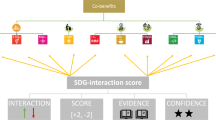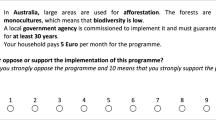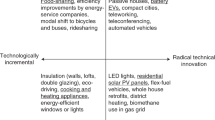Abstract
Cookstove carbon offset projects can progress multiple Sustainable Development Goals (SDGs), including climate, energy, health, gender, poverty and deforestation. However, project emission reductions must be accurately or conservatively estimated to avoid undermining climate action and long-term SDG financing. Here we conduct a comprehensive, quantitative, quality assessment of offsets by comparing five cookstove methodologies with published literature and our own analysis. We find misalignment, in order of importance, with fraction of non-renewable biomass, firewood–charcoal conversion, stove adoption, stove usage, fuel consumption, stacking (using multiple stoves), rebound and emission factors. Additionality, leakage, permanence and overlapping claims require more research. We estimate that our project sample is over-credited 9.2 times. Gold Standard’s metered methodology, which directly monitors fuel use, is most aligned with our estimates (1.5 times over-credited) and has the largest potential for emission abatement and health benefit. We provide recommendations to align methodologies with current science and SDG progress.
This is a preview of subscription content, access via your institution
Access options
Access Nature and 54 other Nature Portfolio journals
Get Nature+, our best-value online-access subscription
$29.99 / 30 days
cancel any time
Subscribe to this journal
Receive 12 digital issues and online access to articles
$119.00 per year
only $9.92 per issue
Buy this article
- Purchase on Springer Link
- Instant access to full article PDF
Prices may be subject to local taxes which are calculated during checkout



Similar content being viewed by others
Data availability
All data and code are publicly available online at https://github.com/agillwiehl/GillWiehl_et_al_Pervasive_over_crediting.
Code availability
All data and code are publicly available online at https://github.com/agillwiehl/GillWiehl_et_al_Pervasive_over_crediting.
References
Abbafati, C. et al. Global burden of 87 risk factors in 204 countries and territories, 1990–2019: a systematic analysis for the Global Burden of Disease Study 2019. Lancet 396, 1223–1249 (2020).
Bailis, R., Drigo, R., Ghilardi, A. & Masera, O. The carbon footprint of traditional woodfuels. Nat. Clim. Change 5, 266–272 (2015).
Defining clean fuels and technologies. World Health Organization https://www.who.int/tools/clean-household-energy-solutions-toolkit/module-7-defining-clean (2021).
So I., Haya, B. & Elias, M. Voluntary registry offsets database v.8. University of California, Berkeley https://gspp.berkeley.edu/faculty-and-impact/centers/cepp/projects/berkeley-carbon-trading-project/offsets-database (2023).
Stapp, J. et al. Little evidence of management change in California’s forest offset program. Commun. Earth Environ. 4, 331 (2023).
Haya, B. Policy Brief: the California Air Resources Board’s US Forest Offset Protocol Underestimates Leakage (Goldman School of Public Policy, University of California, Berkeley, 2019); https://gspp.berkeley.edu/assets/uploads/research/pdf/Policy_Brief-US_Forest_Projects-Leakage-Haya_4.pdf
Haya, B. et al. Quality assessment of REDD+ carbon credit projects. Berkeley carbon trading project. Goldman School of Public Policy, University of California, Berkeley https://gspp.berkeley.edu/research-and-impact/centers/cepp/projects/berkeley-carbon-trading-project/REDD (2023).
West, T. A. P. et al. Action needed to make carbon offsets from forest conservation work for climate change mitigation. Science 381, 873–877 (2023).
Cames, M. et al. How additional is the clean development mechanism? Analysis of the application of current tools and proposed alternatives. DG CLIMA https://doi.org/10.13140/RG.2.2.23258.54728 (2016).
Haya, B. K. Carbon Offsetting: An Efficient Way to Reduce Emissions or to Avoid Reducing Emissions? An Investigation and Analysis of Offsetting Design and Practice in India and China. PhD thesis, University of California, Berkeley (2010).
Bailis, R., Wang, Y., Drigo, R., Ghilardi, A. & Masera, O. Getting the numbers right: revisiting woodfuel sustainability in the developing world. Environ. Res. Lett. 12, 115002 (2017).
Ramanathan, T. et al. Wireless sensors linked to climate financing for globally affordable clean cooking. Nat. Clim. Change 7, 44–47 (2017).
Freeman, O. E. & Zerriffi, H. How you count carbon matters: implications of differing cookstove carbon credit methodologies for climate and development cobenefits. Environ. Sci. Technol. 48, 14112–14120 (2014).
Sanford, L. & Burney, J. Cookstoves illustrate the need for a comprehensive carbon market. Environ. Res. Lett. 10, 084026 (2015).
Simon, G. L., Bumpus, A. G. & Mann, P. Win–win scenarios at the climate–development interface: challenges and opportunities for stove replacement programs through carbon finance. Glob. Environ. Change 22, 275–287 (2012).
Lee, C. M., Chandler, C., Lazarus, M. & Johnson, F. X. Assessing the climate impacts of cookstove projects: issues in emissions accounting. Chall. Sustain. 1, 53–71 (2013).
Reduced emissions from cooking and heating—technologies and practices to displace decentralized thermal energy consumption (TPDDTEC). The Gold Standard Foundation https://globalgoals.goldstandard.org/407-ee-ics-technologies-and-practices-to-displace-decentrilized-thermal-energy-tpddtec-consumption/ (2021).
The Gold Standard simplified methodology for clean and efficient cookstoves. The Gold Standard Foundation https://globalgoals.goldstandard.org/408-ee-ics-simplified-methodology-for-efficient-cookstoves/ (2022).
AMS-II.G.: energy efficiency measures in thermal applications of non-renewable biomass version 12.0. Clean Development Mechanism https://cdm.unfccc.int/methodologies/DB/10PELMPDW951SVSW1B2NRCQEBAX96C (2022).
AMS-I.E.: switch from non-renewable biomass for thermal applications by the user version 12.0. Clean Development Mechanism https://cdm.unfccc.int/methodologies/DB/BLVN9ULDP1FRUVS2LYWW6WPYN9W78E (2021).
Methodology for metered and measured energy cooking devices. The Gold Standard Foundation https://globalgoals.goldstandard.org/news-methodology-for-metered-measured-energy-cooking-devices/ (2022).
Krumpal, I. Determinants of social desirability bias in sensitive surveys: a literature review. Qual. Quant. 47, 2025–2047 (2013).
Kar, A., Brauer, M., Bailis, R. & Zerriffi, H. The risk of survey bias in self-reports vs. actual consumption of clean cooking fuels. World Dev. Perspect. 18, 100199 (2020).
Wilson, D. L. et al. in Technologies for Development (eds Hostettler S. et al.) 211–221 (Springer, 2015).
Simons, A. M., Beltramo, T., Blalock, G. & Levine, D. I. Using unobtrusive sensors to measure and minimize Hawthorne effects: evidence from cookstoves. J. Environ. Econ. Manage. 86, 68–80 (2017).
Shankar, A. V. et al. Everybody stacks: lessons from household energy case studies to inform design principles for clean energy transitions. Energy Policy 141, 111468 (2020).
Hanna, R., Duflo, E. & Greenstone, M. Up in smoke: the influence of household behavior on the long-run impact of improved cooking stoves. Am. Econ. J. Econ. Policy 8, 80–114 (2016).
Burwen, J. & Levine, D. I. A rapid assessment randomized-controlled trial of improved cookstoves in rural Ghana. Energy Sustain Dev. 16, 328–338 (2012).
Beltramo, T., Blalock, G., Harrell, S., Levine, D. & Simons, A. M. The effects of fuel-efficient cookstoves on fuel use, particulate matter, and cooking practices: results from a randomized trial in rural Uganda. UC Berkeley Center for Effective Global Action https://escholarship.org/uc/item/365778pn (2019).
Rosa, G. et al. Assessing the impact of water filters and improved cook stoves on drinking water quality and household air pollution: a randomised controlled trial in Rwanda. PLoS ONE 9, e91011 (2014).
Bensch, G. & Peters, J. The intensive margin of technology adoption—experimental evidence on improved cooking stoves in rural Senegal. J. Health Econ. 42, 44–63 (2015).
Ruiz-Mercado, I., Masera, O., Zamora, H. & Smith, K. R. Adoption and sustained use of improved cookstoves. Energy Policy 39, 7557–7566 (2011).
Islam, M. M. et al. Assessing the effects of stove use patterns and kitchen chimneys on indoor air quality during a multiyear cookstove randomized control trial in rural India. Environ. Sci. Technol. 56, 8326–8337 (2022).
García-Frapolli, E. et al. Beyond fuelwood savings: valuing the economic benefits of introducing improved biomass cookstoves in the Purépecha Region of Mexico. Ecol. Econ. 69, 2598–2605 (2010).
Agurto Adrianzén, M. Social capital and improved stoves usage decisions in the Northern Peruvian Andes. World Dev. 54, 1–17 (2014).
Jeuland, M., Soo, J. S. T. & Shindell, D. The need for policies to reduce the costs of cleaner cooking in low income settings: implications from systematic analysis of costs and benefits. Energy Policy 121, 275–285 (2018).
Ruiz-Mercado, I., Canuz, E., Walker, J. L. & Smith, K. R. Quantitative metrics of stove adoption using stove use monitors (SUMs). Biomass Bioenergy 57, 136–148 (2013).
Pine, K. et al. Adoption and use of improved biomass stoves in rural Mexico. Energy Sustain. Dev. 15, 176–183 (2011).
Pattanayak, S. K. et al. Experimental evidence on promotion of electric and improved biomass cookstoves. Proc. Natl Acad. Sci. USA 116, 13282–13287 (2019).
MP88: meeting report/recommendations to the executive board. CDM Methodologies Panel https://cdm.unfccc.int/Panels/meth/index.html (2022).
Life cycle assessment of cooking fuel systems in India, China, Kenya, and Ghana. US Environmental Protection Agency https://cfpub.epa.gov/si/si_public_record_report.cfm?dirEntryId=339679&Lab=NRMRL&simplesearch=0&showcriteria=2&sortby=pubDate&timstype=Published+Report&datebeginpublishedpresented (2021).
Wathore, R., Mortimer, K. & Grieshop, A. P. In-use emissions and estimated impacts of traditional, natural- and forced-draft cookstoves in rural Malawi. Environ. Sci. Technol. 51, 1929–1938 (2017).
Stockwell, T. et al. Estimating under- and over-reporting of drinking in national surveys of alcohol consumption: identification of consistent biases across four English-speaking countries. Addiction 111, 1203–1213 (2016).
Ezzati, M., Martin, H., Skjold, S., Hoorn, S. V. & Murray, C. J. L. Trends in national and state-level obesity in the USA after correction for self-report bias: analysis of health surveys. J. R. Soc. Med. 99, 250–257 (2006).
Concept Note CDM-MP85-A07. Analysis and Options Regarding Caps Used in AMS-I.E, AMS-II.G and TOOL30 Version 01.0 (Clean Development Mechanism, 2013); https://cdm.unfccc.int/sunsetcms/storage/contents/stored-file-20210708220535947/MP85_EA07_Concept%20Note%20-%20Caps.pdf
Daioglou, V., van Ruijven, B. J. & van Vuuren, D. P. Model projections for household energy use in developing countries. Energy 37, 601–615 (2012).
Tool 30: calculation of the fraction of non-renewable biomass (version 3). Clean Development Mechanism https://cdm.unfccc.int/methodologies/PAmethodologies/tools/am-tool-30-v1.pdf/history_view (2020).
Ghilardi, A. et al. Spatiotemporal modeling of fuelwood environmental impacts: towards improved accounting for non-renewable biomass. Environ. Model Softw. 82, 241–254 (2016).
Floess, E. et al. Scaling up gas and electric cooking in low- and middle-income countries: climate threat or mitigation strategy with co-benefits? Environ. Res. Lett. 18, 034010 (2023).
Whitman, T. L. & Lehmann, C. J. Systematic under and overestimation of GHG reductions in renewable biomass systems. Clim. Change 104, 415–422 (2011).
Huang, Y. et al. Global radiative effects of solid fuel cookstove aerosol emissions. Atmos. Chem. Phys. 18, 5219–5233 (2018).
Bailis R., et al. Enhancing clean cooking options in peri-urban Kenya: a pilot study of advanced gasifier stove adoption. Environ. Res. Lett. 15, 084017 (2020).
Forum on natural capital accounting for better policy decisions: taking stock and moving forward. World Bank Group http://documents.worldbank.org/curated/en/904211580129561872/Forum-on-Natural-Capital-Accounting-for-Better-Policy-Decisions-Taking-Stock-and-Moving-Forward (2017).
Dufournaud, C. M., Quinn, J. T. & Harrington, J. J. A partial equilibrium analysis of the impact of introducing more-efficient wood-burning stoves into households in the Sahelian Region. Environ. Plan. Econ. Space 26, 407–414 (1994).
Lambe, F. et al. Opening the black pot: a service design-driven approach to understanding the use of cleaner cookstoves in peri-urban Kenya. Energy Res. Soc. Sci. 70, 101754 (2020).
ISO/IEC 17029:2019 general principles and requirements for validation and verification bodies. ISO https://www.iso.org/standard/29352.html (2019).
Khavari, B., Ramirez, C., Jeuland, M. & Fuso Nerini, F. A geospatial approach to understanding clean cooking challenges in sub-Saharan Africa. Nat. Sustain. 6, 447–457 (2023).
Bakhtary, H., Tierney, M., Galt, H. & Gill-Wiehl, A. More than just a Carbon Project: How Clean Cooking Projects Certified Under the Gold Standard Approach SDG Claims (Climate Focus, 2023); https://mecs.org.uk/wp-content/uploads/2023/05/FINAL-SDG-Briefing-More-than-just-a-carbon-project.pdf
Gill-Wiehl, A. & Kammen, D. M. A pro-health cookstove strategy to advance energy, social and ecological justice. Nat. Energy 7, 999–1002 (2022).
The handbook for programme of activities: practical guidance to successful implementation. Climate Focus https://climatefocus.com/publications/handbook-programmes-activities-practical-guidance-successful-implementation/ (2011).
Fitzpatrick, D. in Analog Design and Simulation Using OrCAD Capture and PSpice 2nd edn (ed Fitzpatrick, D.) 151–164 (Newnes, 2018).
Robinson, B. L., Clifford, M. J., Hewitt, J. & Jewitt, S. Cooking for communities, children and cows: lessons learned from institutional cookstoves in Nepal. Energy Sustain. Dev. 66, 1–11 (2022).
Gill-Wiehl, A., Hogan, M. & Haya, B. A comprehensive quality assessment of cookstoves carbon credits. Golman School of Public Policy, University of California, Berkeley https://gspp.berkeley.edu/research-and-impact/centers/cepp/projects/berkeley-carbon-trading-project/cookstoves (2023).
Acknowledgements
The research that led to these results received funding from the Center for African Studies, University of California, Berkeley (A.G.-W.), Carbon Direct (B.K.H.), Google.org (D.K.), Katherine Lau Family Foundation (A.G.-W. and D.K.), the National Science Foundation’s Graduate Researcher Fellowship Program (A.G.-W.), the Mulago Foundation/Better Cooking Company (A.G.-W.) and the Zaffaroni Family Foundation (D.K.). We thank A. Haya for help with initial data collection. We also thank Calyx Global and D. Lee. A.G.-W. thanks I. Ray and A. Hubbard for additional advising support.
Author information
Authors and Affiliations
Contributions
A.G.-W. and B.K.H. co-led the research design. A.G.-W. compiled the data, conducted the analysis and co-led the write up of the paper. B.K.H. originated the idea and co-led the write up of the paper. D.K. contributed to the research design and write up, as well as funding the work.
Corresponding author
Ethics declarations
Competing interests
A.G.-W. has received research support from Better Cooking Company Limited, whose leadership also provided comments on a draft of the manuscript. B.K.H. has received research support from Carbon Direct. D.K. declares no competeing interests.
Peer review
Peer review information
Nature Sustainability thanks Philippe Delacote, Ben Groom and Bruno Marino for their contribution to the peer review of this work.
Additional information
Publisher’s note Springer Nature remains neutral with regard to jurisdictional claims in published maps and institutional affiliations.
Supplementary information
Supplementary Information
Supplementary extended methods, Figs. 1–3, Tables 1–23, discussion of health benefits, co-benefits, methodology equations and methodology surveys; our sample of projects; studies included in our adoption, usage, stacking, additionality and leakage investigations; overview of monitoring types; additional results: all over-crediting results; sensitivity analysis; MCM histogram; location analysis.
Rights and permissions
Springer Nature or its licensor (e.g. a society or other partner) holds exclusive rights to this article under a publishing agreement with the author(s) or other rightsholder(s); author self-archiving of the accepted manuscript version of this article is solely governed by the terms of such publishing agreement and applicable law.
About this article
Cite this article
Gill-Wiehl, A., Kammen, D.M. & Haya, B.K. Pervasive over-crediting from cookstove offset methodologies. Nat Sustain 7, 191–202 (2024). https://doi.org/10.1038/s41893-023-01259-6
Received:
Accepted:
Published:
Issue Date:
DOI: https://doi.org/10.1038/s41893-023-01259-6
This article is cited by
-
Strong transparency required for carbon credit mechanisms
Nature Sustainability (2024)



